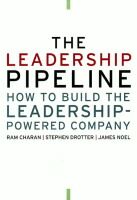 As I left for an overseas trip, I rummaged through my bookcase of “books to be read” and selected the clean, white cover of The Leadership Pipeline, by James Noel, Stephen Drotter and Steven Drotter (Buy it at Amazon.com or Kalahari.net). I’ve only just got into it, but I am intrigued and am already making notes.
As I left for an overseas trip, I rummaged through my bookcase of “books to be read” and selected the clean, white cover of The Leadership Pipeline, by James Noel, Stephen Drotter and Steven Drotter (Buy it at Amazon.com or Kalahari.net). I’ve only just got into it, but I am intrigued and am already making notes.
The authors are focused on helping companies to develop their own leadership capacity from within – an essential capability given the talent wars going on in the world. Leaders leave if they are too challenged or not challenged enough. One of the problems is that companies don’t correctly identify the significant leadership “passages” that happen as leaders move from one level of responsibility to another. This book identifies 7 key stages of leadership, and therefore 6 major inflection points on the leaders journey. The seven stages are: Managing self (professional focused on output of skill), Managing others (first level supervision), Manage Managers (no more “front end” delivery required), Functional Manager (managing an entire department or business line function), Business Manager, Group Manager (a manager of multiple businesses, possibly across geographic regions), and Enterprise Manager (CEO).
This obviously applies best to a large, diversified organisation, but can be “flattened” to apply to small or medium-sized companies.
At each transition point, people need to learn new skills, adjust their “values” (the authors use this word to denote what people focus on and value, rather than the global, character-based issues I might use the word for) and realign their time allocation. The leadership passages then are as follows:
- Passage one — from managing self to managing others
Development needed: the ability to plan, assign, motivate, measure and coach work through others, while still doing their own work as well. The key need is to learn to value (“focus on” / “enjoy”) managerial work rather than just tolerating it. They need to adjust to believing that time spent on others is mission critical to their own success at this new level of leadership. - Passage two — from managing others to managing managers
Development needed: how to select people to go through Passage one (i.e. building a leadership team below you) – and to know when to send super stars back down again if they don’t make the transition -, beginnings of a focus on strategic issues, and the move to pure management. - Passage three — from managing managers to functional manager
Development needed: new communication skills (to different levels of the team – up and down), managing areas outside your own professional expertise/experience, blending functional strategy with the overall business strategy. - Passage four — from functional manager to business manager
Development needed: longer-term, profit-focussed view, rather than a functional one, balancing short-term and long-term thinking, reflection and analysis, and directing and managing staff (admin, legal, finance, HR – head office) functions. - Passage five — from business manager to group manager
Development needed: Focus on success of other people’s business – not getting all the reward for yourself; Four key skill sets required: evaluate strategies for captial allocation and deployment purposes; preparing function managers to become business managers (including coaching); portfolio strategy – knowing which businesses to add or remove from a group; and, being objective about success, based on analysis and experience. They must be aware of the bigger decisions, greater risks and uncertainties and longer time spans inherent at this new leadership level. - Passage six — from group manager to enterprise manager (CEO)
Development needed: The key focus is on values. The CEO’s job involves 3 to 4 high-leverage, major decisions a year, and these must be the focus. They must be visionary (not just strategic) leaders, who know how to translate their vision into quarterly results for their stakeholders. The focus is almost entirely external and must be proactive, not reactive. The focus is on the whole, not the parts. Its key to develop a strong team immediately below you – even if they all want your job.
Each turn/passage requires a major change in skills; time applications — new time frames that govern how a individual works; and work values — what an individual believes is important and makes the focus of his or her efforts. The challenge is to ensure that people in leadership positions are not working at one level while clinging to the skills, time applications or values appropriate for another. They must be measured against what their leadership level is expected to contribute to the company, or else they can clog the pipeline.
More info will follow as I get into the very practical looking chapters on each of these passages.
Technorati tags: leadership, ceo, business, talent


